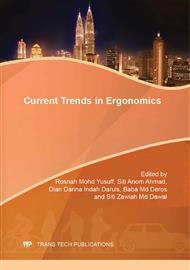[1]
Accidents Statistic, Department of Safety and Health, Ministry of Human Resource, Kuala Lumpur, Malaysia, (2012).
Google Scholar
[2]
M. S. Misnan, A. H. Mohammed and W. Y. Mahmood, Development of Safety Culture in The Construction Industry: The Leadership and Training Roles, Proceeding of the 2nd International Conference on Built Environment in Developing Countries (ICBEDC), Johor, Malaysia, (2008).
Google Scholar
[3]
F. B. Cambraia, C. T. Formoso and T. A. Saurin, An analysis of construction safety best practices from cognitive systems engineering perspective, Safety Science, vol. 10, pp.1-15, Brazil, (2007).
DOI: 10.1016/j.ssci.2007.07.007
Google Scholar
[4]
K. H. E. Kroemer, H. J. Kroemer and Kroemer Elbert, K. E., Engineering Physiology: Base of Human Factor/Ergonomics, 2nd edition, New York: Reinhold, (1990).
DOI: 10.1007/978-3-030-40627-1
Google Scholar
[5]
N. Haste, Accidents and Agenda: An examination of the processes that follow from accidents in high potential in several industries and their effectiveness in preventing further accidents, The Royal Academy of Engineering, http: /www. raeng. org. uk/news/publications/, July (2007).
Google Scholar
[6]
J. A. Gambatese, M. Behm, and J. Hinze, Viability of designing for construction worker safety, Journal of Construction Engineering Management, pp.1029-1036, (2005).
DOI: 10.1061/(asce)0733-9364(2005)131:9(1029)
Google Scholar
[7]
S. A. Shappell and D. A. Wiegmann, A human error approach to accident investigation: the taxonomy of unsafe operations, International Journal Aviation Psychological, pp.269-291, (1997).
DOI: 10.1207/s15327108ijap0704_2
Google Scholar
[8]
A. R. A. Hamid, Hazards at Construction Sites, Proceeding of the 5th Asia Pacific Structural Engineering and Construction Conference (APSEC), Johor Bahru, Malaysia, (2003).
Google Scholar
[9]
V. J. Davies and K. Tomasin, Construction Safety Handbook, London: Thomas Telford, (1990).
Google Scholar
[10]
R. W. King and R. Hudson, Construction Hazard and Safety Handbook, London, (1985).
Google Scholar
[11]
Division of Occupational Safety and Health, Washington, (2011).
Google Scholar
[12]
R. T. Booth, The role of human factors and safety culture in safety management, Successful Management for Safety, London, (1993).
Google Scholar
[13]
M. S. Misnan and A. H. Mohammed, Development of Safety Culture in the Construction Industry: A Conceptual Framework, Proceeding of the 23rd Annual Conference, Belfast, United Kingdom, pp.45-49, September 3-5, (2007).
Google Scholar
[14]
N. Guo and S. Yu, Study on construction worker safety performance improvement model in China, Applied Mechanics and Materials, vols. 174-177, pp.2729-2733, Hong Kong, (2012).
DOI: 10.4028/www.scientific.net/amm.174-177.2729
Google Scholar
[15]
M. O. Jannadi, Impact of human relations on the safety of construction workers, International Journal of Project Management, vol. 13, no. 6, pp.383-386, (1995).
DOI: 10.1016/0263-7863(95)00031-3
Google Scholar
[16]
D. Langford, S. Rowlinson and E. Sawacha, Safety behaviour and safety management: its influence on the attitudes of workers in the UK construction industry, Engineering, Construction and Architectural Management, vol. 7, iss. 2, pp.133-140, (2000).
DOI: 10.1108/eb021138
Google Scholar
[17]
N. Chileshe, The effect of age on the job satisfaction of construction workers, Australia, (2010).
Google Scholar
[18]
M. Helander, Human Factors Engineering in Construction Work, Construction, Management and Engineering, pp.141-182, New York, NY: John Wiley & Sons. Inc, (1981).
Google Scholar
[19]
K. H. E. Kroemer, H. J. Kroemer and Kroemer Elbert, Ergonomics: How to Design Ease and Efficienc", 2nd edition, Englewood Cliffs, NJ: Prentice Hall, (2001).
DOI: 10.1177/106480469700500208
Google Scholar
[20]
D. W. Christopher, E. G. Sallie , and Yili Liu, Introduction to Human Engineering, 2nd edition, Reinland, (2004).
Google Scholar
[21]
R. A. Haslam, S. A. Hide, A. G. F. Gibb, D. E. Gyi, T. Pavitt, S. Atkinson and A. R. Duff, Contributing factors in construction accidents, Applied Ergonomics, vol. 36, pp.401-415 (2005).
DOI: 10.1016/j.apergo.2004.12.002
Google Scholar
[22]
B. Hare and I. Cameron, Site Manager Safety Training, Engineering, Construction and Management, vol. 18, no. 6, pp.568-578, UK: Glasgow, (2011).
DOI: 10.1108/09699981111180881
Google Scholar


